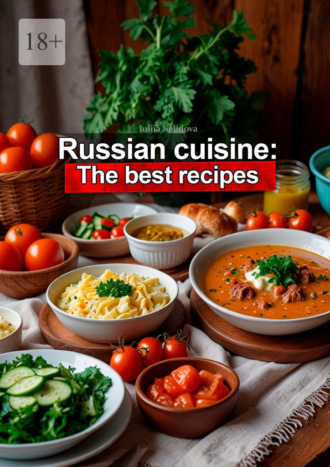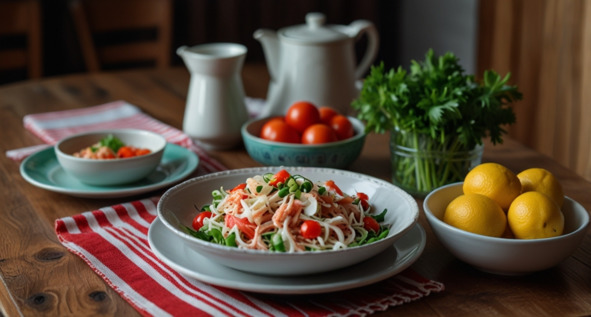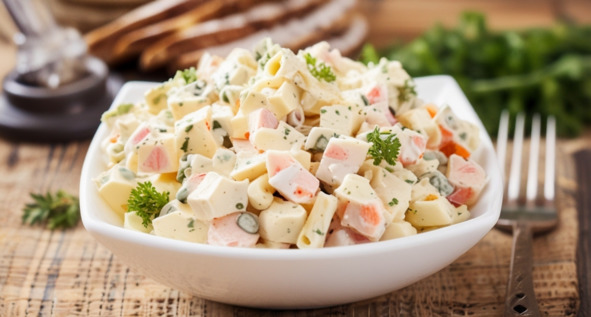
Russian cuisine: The best recipes

Russian cuisine: The best recipes
Iuliia Nelidova
© Iuliia Nelidova, 2025
ISBN 978-5-0065-8888-2
Создано в интеллектуальной издательской системе Ridero
Introduction
The History of Russian Cuisine
Russian cuisine is not just a collection of recipes; it is a whole culture that reflects the centuries-old history, traditions, and customs of our people. Each region of Russia has its unique dishes and culinary habits, but at the heart of all these diversities lie common elements that make Russian cuisine so distinctive and recognizable.
Roots of Russian Cuisine
The history of Russian cuisine dates back to ancient times when our ancestors were hunters and gatherers. Their diet was primarily composed of wild plants, berries, fish, and meat. Over time, with the development of agriculture, grain crops (rye, wheat, and barley) became actively included in their diet. These products formed the basis of many traditional dishes, such as porridge and bread.
With the advent of Christianity in the 10th century, culinary traditions began to change. During this time, lean dishes became popular, as the church prescribed certain days for abstaining from meat and dairy products. This led to a variety of vegetable and mushroom dishes, as well as the creation of various pickles and marinades, which still hold an important place on our table today.
Influence of Neighbors
Russian cuisine did not develop in isolation. Over the centuries, it has been influenced by neighboring cultures. For example, the Mongol invasion in the 13th century brought new methods of preparing meat and dairy products. In the 16th and 17th centuries, during the reign of Tsar Ivan the Terrible, Italian and French culinary traditions were introduced to Russia, leading to the emergence of new dishes and techniques, such as baking and the use of sauces.
Siberia and the Far East also contributed to Russian cuisine. With the introduction of new products, such as fish, venison, and wild berries, the variety of dishes became even richer. This was a time when Russian cuisine began to acquire its unique features, combining elements from various cultures.

Traditional Dishes
Among the many traditional dishes that we know today, special mention goes to borscht, dumplings (pelmeni), pancakes (blini), porridge, and various pies. These dishes are not only delicious but also rich in symbolism and history. For example, borscht is not just a soup; it symbolizes home comfort and family traditions. Dumplings, which were once food for travelers, have become an integral part of Russian cuisine and are popular throughout all regions of Russia.
Modern Trends
Today, Russian cuisine continues to evolve. Young chefs strive to combine traditions with modern culinary techniques, creating new flavor combinations and original presentations. We see how classic dishes take on new forms, and ancient recipes are adapted to contemporary demands.
However, despite these changes, Russian cuisine retains its roots and spirit. It is a cuisine that brings people together, creates comfort, and fills homes with warmth and joy. In every plate, in every recipe, there is the story of the Russian people, their traditions, and culture.
In the next chapter, we will take a closer look at the main ingredients that form the foundation of Russian cuisine and their significance in the preparation of dishes.
Main Ingredients of Russian Cuisine and Their Significance
Russian cuisine is a rich and diverse world where each ingredient plays its unique role. In this chapter, we will explore the main products that form the basis of many traditional dishes and discover their significance not only in cooking but also in the culture of the Russian people.
1. Bread
Bread is the foundation of Russian cuisine and a symbol of home comfort. In Russia, there are many types of bread: rye, wheat, with seeds and spices. Rye bread holds a special place in our diet as it is rich in fiber and vitamins. There is even a saying: «Bread is the head of everything,» which emphasizes the importance of this product in Russian culture.
An interesting fact: in ancient times, bread was not only eaten but also used in rituals. For example, at weddings, a loaf of bread (karavai) was gifted to the newlyweds, symbolizing prosperity and well-being in the family.
2. Porridge (Kasha)
Porridge is another symbol of Russian cuisine. It is made from various grains: buckwheat, oats, rice, and barley. Each type of porridge has its characteristics and can be served either sweet or savory. Buckwheat porridge, for instance, is known for its health benefits: it contains a lot of protein and vitamins and is an excellent source of energy.
Porridge is often associated with simplicity and heartiness, making it an ideal dish for any time of year. Interestingly, in Russia, porridge was not only a daily meal but also used in festive feasts. For example, during Maslenitsa, a sweet porridge with honey and berries was prepared.
3. Vegetables and Fruits
Vegetables and fruits hold an important place in Russian cuisine. Cabbage, beets, carrots, and potatoes are all not only tasty but also nutritious. Cabbage, for example, is the basis for the famous borscht and sauerkraut, which is an excellent source of vitamin C and probiotics.
Among fruits, special attention should be given to apples and berries. Apples are often used in baking, while berries are used in jams and desserts. Interestingly, Russia has many varieties of wild berries, such as lingonberries, cranberries, and blueberries, which are gathered in the forests and used in cooking.
4. Meat and Fish
Meat and fish are important sources of protein in Russian cuisine. Traditionally, beef, pork, chicken, as well as game and fish are used. Dumplings (pelmeni), for example, are made with various fillings, from pork and beef to fish and mushrooms.
Fish, especially river fish, also plays a significant role in our diet. Salted and smoked fish is often served on festive tables, and «ukha» is a traditional Russian fish soup that is cooked outdoors.
5. Dairy Products
Dairy products, such as sour cream, cottage cheese, and kefir, are an integral part of Russian cuisine. Sour cream is used as a sauce for many dishes, while cottage cheese is used for making pies and desserts. Kefir, in turn, is known for its health benefits and is an excellent source of probiotics.
An interesting fact: in Russia, kefir is considered not just a food product but also a means of maintaining health. Many people consume it to improve digestion and overall well-being.
6Spices and Seasonings
Although Russian cuisine is not famous for its abundance of spices, some play an important role in creating the flavor of dishes. Dill, parsley, garlic, and black pepper are the main seasonings that are often used in cooking. Dill, for example, is added to salads, soups, and meat dishes, giving them a fresh and aromatic taste.
Additionally, spices such as bay leaf and mustard are popular in Russian cuisine, adding zest and depth of flavor.
The main ingredients of Russian cuisine are not just products; they form a whole palette of flavors and aromas that shape Russian culinary tradition. Each of them has its own story and significance, reflecting the richness and diversity of Russian culture. In the next chapter, we will dive into the world of traditional dishes that have become symbols of our cuisine and learn how to prepare them.
Tips for Cooking and Serving
Russian cuisine is not just a collection of recipes but an entire art form that requires attention to detail, an understanding of traditions, and, of course, a love for the cooking process. In this chapter, I will share useful tips for cooking and serving dishes that will help you create a true Russian table and impress your loved ones.
1. Choosing Quality Ingredients
The first rule of successful cooking is selecting quality ingredients. Russian cuisine focuses on fresh and natural products. Here are some tips for choosing them:
Vegetables and Fruits: Opt for seasonal products. They are not only tastier but also healthier. For example, in the fall, use pumpkin and beets, while in the summer, fresh cucumbers and tomatoes are ideal.
Meat and Fish: Try to buy meat and fish from trusted suppliers. Pay attention to color and smell – fresh meat should have a vibrant color and a pleasant aroma.
Dairy Products: Choose products with minimal preservatives and additives. Real sour cream should be thick and have a characteristic sour-milk taste.
2. Cooking Techniques
There are many cooking methods in Russian cuisine, each with its own features. Here are some basic techniques:
Stewing: This is one of the most popular cooking methods in Russian cuisine. It allows you to preserve all the juices and aromas of the ingredients. For example, stewed cabbage with meat is a classic dish that takes time but is worth the effort.
Baking: Baking in the oven is a great way to prepare meat and fish. Use foil or parchment paper to retain juices and flavors. Try baking chicken with potatoes and spices – it’s a simple yet very tasty dish.
Boiling: Boiling is the primary method for making soups and porridges. To make a rich soup, add meat and simmer on low heat. Don’t forget to skim off the foam; this will help make the broth clear. For added appetizing appeal and clarity, you can strain the broth for cabbage soup through a sieve.
3. Herbs and Spices
Proper use of herbs and spices is the secret to creating a unique flavor in dishes. Here are some tips:
Dill and Parsley: These herbs are commonly used in Russian cuisine. Add them to dishes at the end of cooking to preserve their bright aroma.
Garlic: It adds a piquant touch to dishes. Use it fresh for salads or as a seasoning for meat. But be cautious – too much garlic can overpower the flavors of other ingredients.
Salt and Pepper: Don’t forget the basics. Salt enhances flavor, while black pepper adds spiciness. However, try not to oversalt dishes – it’s better to add salt at the end of cooking.
4. Table Setting
Table setting is an important part of a Russian feast. Proper presentation of dishes creates a festive atmosphere. Here are some serving tips:
Plates: Choose traditional Russian plates, such as Gzhel or Khokhloma. They are not only beautiful but also emphasize national character.
Napkins: Use cloth napkins folded into triangles or diamonds. This will add sophistication to your table setting.
Dishes: Serve food in large portion plates so guests can help themselves. This creates an atmosphere of friendliness and community.
5. Traditions and Customs
Don’t forget the traditions that make Russian cuisine unique. For example:
Karavai: At weddings and other celebrations, it is important to serve a karavai. This symbolizes prosperity and well-being. It is usually decorated with dough patterns.
Tea: In Russia, it is customary to drink tea after meals. Serve jam, honey, or sweets with tea. This makes for a great conclusion to the meal.
Cooking and serving dishes from Russian cuisine is not only a process but also an opportunity to create an atmosphere of warmth and comfort. By following these tips, you will not only be able to prepare delicious dishes but also give your loved ones unforgettable moments at the table. In the next chapter, we will dive into the world of traditional Russian dishes and their recipes that are a must-try!
Interesting Facts
Here are some interesting facts about specific dishes in Russian cuisine:
1. Borscht
Variety of Recipes: Borscht has many variations across different regions of Russia and other Eastern European countries. For example, in Ukraine, it is made with cabbage, while in Russia, it often includes meat and potatoes.
Secret Ingredient: Many chefs add a bit of vinegar or lemon juice to borscht to enhance the flavor of the beets and give the dish a vibrant color.
History: Borscht is considered one of the oldest dishes in Slavic cuisine. Its roots go back centuries, and there are many legends about its origin.
2. Pelmeni
Siberian Origin: Pelmeni originated in Siberia, where they were prepared as «traveler’s food.» They could be stored for a long time in the freezer, making them ideal for long journeys.
Family Symbol: In some families, there is a tradition of gathering all family members to make pelmeni together. It’s not just a cooking process but also an opportunity to spend time together.
Filling: Traditionally, pelmeni are filled with meat (usually a mix of pork and beef), but there are also vegetarian options with mushrooms, potatoes, or cabbage.
3. Blini
Maslenitsa Festival: Blini symbolize the sun and the arrival of spring. During Maslenitsa, they are made in large quantities, and each day of the week is dedicated to a specific type of blin.
Variety of Fillings: Blini can be served with both savory fillings (such as caviar or fish) and sweet ones (with jam, honey, or condensed milk).
Thin and Thick: In Russia, there are different types of blini: thin ones (for stuffing) and thick ones (similar to American pancakes).
4. Ukha
Fish Soup: Ukha is not just a fish soup; it is a whole culinary tradition. There are many recipes, and each fisherman has their own «secret» way of preparing it.
Ingredients: Ukha typically uses several types of fish, along with potatoes, carrots, onions, and herbs. The more types of fish used, the richer the flavor.
Serving: Ukha is often served with rye bread and dill, along with a shot of vodka, making it not just a dish but also part of a traditional feast.
5. Kasha
Grain as a Base: Kasha is a staple dish made from various grains, such as oats, buckwheat, rice, and barley. Each type of kasha has its unique nutritional properties.
Sweet and Savory: Kasha can be prepared in both sweet and savory variations. For example, semolina kasha is often served with sugar and butter, while buckwheat is served with meat or vegetables.
Symbol of Prosperity: In Russian culture, kasha is considered a symbol of abundance and well-being. In some regions, it is prepared for holidays and celebrations.
6. Herring Under a Fur Coat (Shuba)
Layered Salad: This popular salad consists of layers of boiled herring, potatoes, carrots, beets, and mayonnaise. Each layer adds a unique flavor and texture to the dish.
Origin Story: Herring under a fur coat appeared in Russia in the early 20th century and quickly gained popularity on festive tables.
Creative Variations: There are many variations of this salad, including vegetarian versions without fish or with added ingredients like apples or mushrooms.
7. Okroshka
Summer Soup: Okroshka is a cold soup that is perfect for hot summer days. It is made with kvass or kefir and contains chopped vegetables, meat, and herbs.
Variety of Ingredients: Almost any fresh vegetables and leftover meat can be added to okroshka, making it a versatile dish.
History: Okroshka has ancient roots and likely originated as a way to use up food scraps.
These facts highlight the richness and diversity of Russian cuisine, as well as its connection to cultural traditions and history.
Section 1: Appetizers
Crab Stick Salad
Crab stick salad is a light, delicious, and very easy-to-make dish that is perfect for a festive table or as an everyday snack. It combines the tender taste of seafood with the freshness of vegetables. Let’s go through how to prepare this salad and share some useful tips and interesting facts.
Ingredients:Crab sticks – 200 g
Chicken eggs – 3 pcs
Fresh cucumber – 1 pc (you can also use pickled cucumber if desired)
Canned corn – 1 can (340 g)
Mayonnaise – 3—4 tablespoons (to taste)
Fresh dill – a small bunch (optional)
Green onion – 1 stalk (optional)
Salt and pepper – to taste
DirectionsIngredient Preparation:
Boil the eggs in boiling water for 10 minutes. After that, cool them under cold water, peel, and cut into cubes.
Cut the crab sticks into pieces about 1 cm long. If they are frozen, let them thaw before cutting.
Dice the cucumber into small cubes. If using pickled cucumber, be sure to taste it to avoid over-salting the salad.
Mixing Ingredients:
In a deep bowl, combine the chopped crab sticks, eggs, cucumber, canned corn (drained), and green onion.
Add mayonnaise and mix all the ingredients until well combined. If necessary, add salt and pepper to taste.
Serving:
Transfer the salad to a serving bowl or a flat dish. For decoration, you can sprinkle finely chopped dill on top.

Cooking Tips
For a Richer Flavor: Try adding a bit of lemon juice or mustard to the mayonnaise in the salad. This will give it a fresh and slightly tangy kick.
Texture: If you want the salad to be crunchier, add some fresh bell pepper or radishes.
Prepare in Advance: The salad can be prepared ahead of time, but do not add the mayonnaise until serving to prevent it from getting soggy. Store it in the refrigerator in a sealed container.
Interesting Facts
History of Crab Sticks: Crab sticks were developed in Japan in the 1970s and quickly gained popularity worldwide. They are made from surimi – processed fish – which makes them affordable and accessible.
Health Benefits: Crab stick salad can be low in calories if you use light mayonnaise or substitute it with yogurt. It’s a great option for those who are watching their diet.
Variations: There are many variations of this salad. You can add avocado, rice, or even seaweed for a different taste and texture.
Now you know how to prepare a delicious and appetizing crab stick salad. This dish will make a great addition to your table. Enjoy your meal!
Herring Under a Fur Coat
Ingredients:Herring fillet – 300 g
Potatoes – 3—4 pcs (medium-sized)
Carrots – 2 pcs
Beets – 1—2 pcs (depending on size)
Eggs – 3 pcs
Onion (optional) – 1 pc
Mayonnaise – 200 g
Fresh dill – for decoration
Salt and pepper – to taste
DirectionsIngredient Preparation:
Boil the potatoes, carrots, and beets in their skins until cooked. This will preserve their flavor and nutrients. Cool and peel them.
Hard boil the eggs (about 10 minutes after boiling). Cool and peel.
Chopping:
Cut the herring fillet into small cubes.
Grate the potatoes and carrots on a coarse grater.
Grate the beets on a coarse grater or cut them into small cubes.
Separate the eggs into whites and yolks. Grate the whites, and you can mash the yolks with a fork.
Assembling the Salad:
On a flat dish, lay the first layer – half of the grated potatoes. Lightly salt and spread with mayonnaise.
For the second layer, add the herring. Again, spread with mayonnaise.
The third layer is the grated carrots. Lightly salt and spread with mayonnaise.
The fourth layer is the grated egg whites. Spread with mayonnaise.
The fifth layer is the grated beets. Spread with mayonnaise and carefully smooth it out.
Finish the salad with the grated yolks, sprinkling them on top for decoration.
Chilling:
Refrigerate the salad for at least 2—3 hours, preferably overnight. This will allow all the flavors to meld and make the dish more flavorful.
Serving:
Before serving, decorate the salad with fresh dill. You can also add a few lemon slices for brightness.
Cooking Tips
For a Richer Flavor: Use pickled herring or add a bit of lemon juice to the mayonnaise. This will give the dish a fresh taste.
To Prevent Beets from Coloring Other Layers: You can coat the beets with mayonnaise beforehand. This will prevent them from staining the other ingredients. However, in this case, the red color will not be as vibrant, and the salad will be less contrasting.
For a Lighter Option: Substitute mayonnaise with Greek yogurt or mix them in equal parts.
Interesting Facts
Origin: Herring under a fur coat appeared in Russia in the early 20th century and quickly became popular on festive tables, especially for New Year’s and other celebrations.
Symbol of Winter: Herring under a fur coat is associated with winter holidays and has become an integral part of Russian culinary tradition.
Culinary Experiment: Variations of this salad exist in different countries. For example, in some regions, apples or peas are added, giving the dish a unique flavor.
Enjoy your meal! Herring under a fur coat is not only a delicious dish but also a beautiful one that will adorn any festive table.
Olivier Salad
Ingredients:Potatoes – 3—4 pcs (medium-sized)
Carrots – 2 pcs
Eggs – 4 pcs
Pickled cucumbers – 3—4 pcs
Green peas (canned) – 1 can (400 g)
Chicken fillet (or sausage/ham) – 300 g
Onion (optional) – 1 pc
Mayonnaise – 200—250 g
Salt and pepper – to taste
Greens (dill or parsley) – for decoration
DirectionsIngredient Preparation:
Boil the carrots and potatoes in their skins until cooked. Once cooled, peel and cut into cubes.
Hard boil the eggs (about 10 minutes), cool, peel, and chop finely.
If using chicken fillet, boil it until cooked, cool, and cut into cubes. Ham or sausage can simply be cut into cubes.
Assembling the Salad:
In a deep bowl, mix all the prepared ingredients: potatoes, carrots, eggs, pickled cucumbers, chicken (or ham/sausage), and green peas.
If desired, add finely chopped onion for a sharper flavor.
Dress the salad with mayonnaise, adding salt and pepper to taste. Mix well to ensure all ingredients are evenly combined.
Serving:
Transfer the salad to a beautiful serving dish. Garnish with greens before serving at the table.

Cooking Tips
Ingredient Selection: Use high-quality and fresh products. For a richer flavor, opt for homemade mayonnaise or make it yourself.
Chilling: Let the salad sit in the refrigerator for at least 1—2 hours before serving to allow all the flavors to blend better.
Variations: Instead of chicken, you can use boiled beef or sausage. You can also add a bit of apple for a touch of sweetness and freshness.






